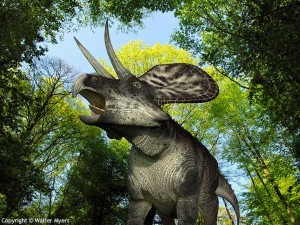by Adrienne Mayor (Regular Contributor)
 “All kinds of beings were changed to stone. We find their forms, sometimes large like the beings themselves, sometimes shriveled and distorted. We see among the rocks the shapes of many beings that live no longer. ” –Zuni elders, 1891
“All kinds of beings were changed to stone. We find their forms, sometimes large like the beings themselves, sometimes shriveled and distorted. We see among the rocks the shapes of many beings that live no longer. ” –Zuni elders, 1891
The Zuni creation story has strong ties to the landscape of volcanic mountains and deeply eroded canyons of the Colorado Plateau (Arizona, Utah, Colorado, New Mexico). Like many other Native cultures, the Zuni believed that our present era was preceded by a series of ages, each populated by different beings.
Origins
In Zuni myth, the new earth was flooded and wracked by earthquakes. Bizarre monsters ruled this dark, watery world, while small proto-humans with clammy skin, goggle eyes, bat ears, tails, and webbed feet crept along like salamanders, barely surviving in muddy island caves. To keep these “unfinished” humans from succumbing to the great monsters of the deep, the Twin Children of the Sun realized that the world needed to be dried out and solidified. With a magical rain-bow and cosmic lightning arrows, the Twin Heroes set tremendous conflagration over the face of the earth, scorching it dry and hardening the ground. Proto-humans emerged into the sunlight and began to become “finished” human beings.
But now, on dry land, huge predators with powerful claws and teeth multiplied and devoured the still-weak human beings. The Twin Heroes stalked across the world, blasting with lightning all the land monsters—gigantic bears, enormous lions, and other immense creatures. Instantly immolated, the dangerous beasts shriveled and became stone.
The Role of Material Objects in Myth Making
The Zuni interpreted the fossilized skeletons of dinosaurs and other extinct creatures that continually weather out of the Southwestern desert as the forms of the old monsters. Large animals transformed to stone were the original We-ma-we, fetishes with “hearts of power,” but they were too big to carry, so the Zuni gathered smaller teeth, claws, and fossil bones as amulets. Zuni carvers, aware of the links between fossils and We-ma-we, have recently begun to make small fetishes in dinosaur shapes.
Extensive exposures of Cretaceous sediments lie in Zuni territory. As Zunis gathered bentonite clay, salt, jet, gems, and minerals they came across the remains of large marine reptiles and dinosaurs with bizarre, horned skulls and huge teeth and talons trapped in rock. It was very good fortune to discover powerful relics from the “days of the new.” Among the most impressive dinosaur fossils in Zuni lands is a ceratopsian theropod with terrible claws, named Zuniceratops. Some 90 million years ago, razor-toothed raptor dinosaurs, duck-billed hadrosaurs, flying pterosaurs, giant centipedes, and tropical trees flourished on the fluctuating western shores of the inland sea that bisected North America, wetlands teeming with prehistoric crocodiles, giant sharks, and immense marine reptiles called mosasaurs. That ecology corresponds to the “days of the new” in Zuni mythology.
The Science Beneath the Stories
The dry climate and exposed topography make the Southwest a veritable textbook of geology. Millions years of geological events have left strong traces for scientists to piece together. The Zuni saw the presence of stone clams, ammonites, fish, large marine fossils, and impressions of ripples and mud cracks on the receding shorelines as proof that a sea had long ago covered the desert. Geological and paleontological clues led the Zuni to perceive that, eons ago, the arid desert was a watery world populated by monsters that no longer exist, followed by a fiery period marked by gigantic land predators that were transformed to stone. Volcanic evidence and lava flows—and living memories of eruptions—supported the Zuni idea of a great conflagration that dried out the young earth.
Some scientists propose that mass extinctions of Permian marine species 250 million years ago may have been caused by underwater explosion of gases, which could have been ignited by a single lightning bolt to set the earth aflame–a scenario remarkably reminiscent of Zuni myth. Paleontologists have discovered evidence of vast prehistoric fires that raged across the land, leaving burnt, petrified stumps, more stark evidence for the Zuni scenario, which also imagined the first humans as evolving from lower lifeforms. Concepts of evolution, extinction, climate change, deep time, geology, and fossils–all contained in one elegant Zuni myth!
Image: Walter Meyers
Adrienne Mayor is the author of Fossil Legends of the First Americans (2005), The First Fossil Hunters (2000, 2011), The Poison King (2010), and The Amazons: Lives and Legends of Warrior Women across the Ancient World (2014).
